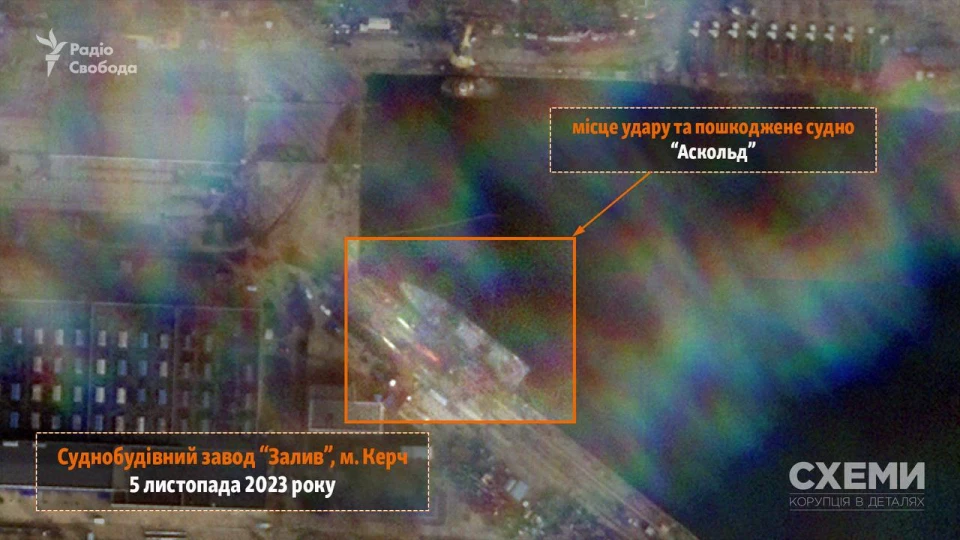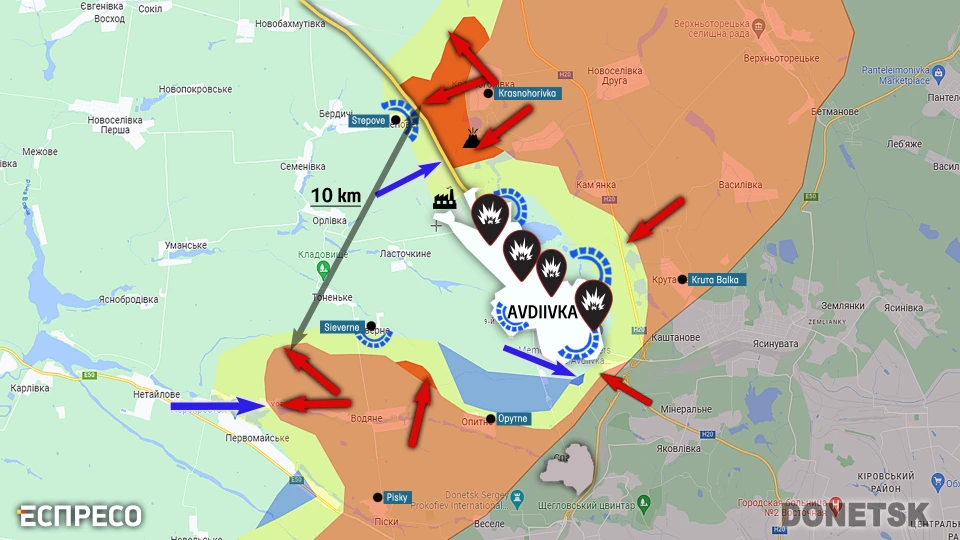
Details and consequences of Ukraine's attack on Zaliv shipyard in Kerch. Column by Serhiy Zgurets
The attack was carried out on November 4 by Ukrainian Air Force aircraft using SCALP cruise missiles, which covered a distance of about 250 kilometers, hitting the enemy ship. This was perhaps the longest-range strike using precision-guided missiles
Russian missile corvette Askold hit
I'll start with the good news, or rather, with the appearance in the public domain of photos and videos that not only confirm but also detail the consequences of the hit on the Askold missile corvette of the Russians during the attack on the Zaliv shipyard in the temporarily occupied Kerch. Anyone who has seen these photos can clearly conclude that the new missile ship was completely destroyed.

Zaliv Shipyard in Kerch, Crimea. November 5, 2023. Scene of strike and damage to the ship Askold
Photo: Schemes/Radio Liberty
It was a hit to its central part, where missile launchers, engines, etc. are located. "The Askold was built at the Zaliv shipyard, underwent state testing, and was to be transferred to the Black Sea Fleet. This is a rather dangerous project, because, despite its compactness, it is, or was, a carrier for 8 Kalibr or Oniks cruise missiles at once.
The attack was carried out on November 4 by aircraft of the Ukrainian Air Force using SCALP cruise missiles, which covered a distance of about 250 km, hitting the enemy ship. This was perhaps the longest-range strike using high-precision missiles received from our partners. We can say that at least two missiles hit the Zaliv plant and another one hit the ship. The surveillance video also shows another flash, which may indicate the explosion of a fourth missile out of frame. At the same time, the enemy claimed that 15 missiles out of 13 were shot down by Russian air defense, but this is a lie. Most likely, these were decoy missiles, which are traditionally launched in tandem with cruise missiles to divert attention and limit the capabilities of Russian air defense.
The frontline situation: Avdiivka sector
Next, we move on to an equally hot area where the enemy has concentrated significant forces and, despite heavy losses, is trying to push the Ukrainian defense through with attacks from the north, south and east - Avdiivka. The attacks began in early October in the format of a new enemy offensive campaign, and have been almost unabated since then. Only sometimes the weather or huge losses affect the intensity of the Russian army's actions.
The Avdiivka bridgehead is surrounded by Russian troops in two 'claws' from the north and south, the distance between these parts of the enemy's thrust is about 8 km. But we understand that the enemy is trying to continue to press in these directions, but without success.
Serhiy Tsehotskyi, an officer of the 59th Separate Motorized Infantry Brigade named after Yakiv Handziuk, said that nothing new is happening around Avdiivka. “On November 7, there were military clashes, attempts to storm the city by the enemy. The occupants were moving in small groups of about 5-6 people. Four attempts were made in the direction of our brigade, but all were unsuccessful on the part of the invaders.”
The officer noted that the enemy's mood was not good, and our fighters could see this from the prisoners and capture. Russians are being chased, they are afraid, but they are coming. However, there are a lot of them, and this is a distraction. Every minute, every hour, our fighters show courage and heroism in their positions. Russian soldiers are acting in a completely non-logical manner, it is impossible to understand them. Today a heavy counter-battery fight took place. Under the cover of artillery shelling, the invaders tried to reach our positions, but all their attempts failed.

Tsekhotskyi emphasized the high proficiency of Ukrainian artillerymen who destroy the enemy on the far outskirts. "The Russians take by numbers, but we take by professionalism. The entire team must be highly skilled to hit the target accurately from the first shot at long range. We see soldiers becoming highly professional before our eyes when they should have been trained for years in academies and military schools. The Ukrainian gene is working and bearing fruit.
Development of Ukrainian means of electronic warfare
And next, let's talk about weapons and technologies for war. The Commander-in-Chief of the Armed Forces Valeriy Zaluzhnyi, in his paper "Modern Positional Warfare and How to Win It," identified electronic warfare systems as one of the five priorities that Ukraine needs to consider in order to develop capabilities to overcome positional warfare. So, further on, we will talk about the development of Ukrainian electronic warfare systems and new projects that our companies are currently testing on the front line.
Anton Mikhnenko, military expert, and editor of the Ukrainian Defense Review magazine by Defense Express, noted that Zaluzhnyi's attention to electronic warfare as a component that will help us win is very important. The vision is that electronic warfare can be key to creating difficult conditions for the enemy and the necessary conditions for us in offensive actions. Electronic warfare is very relevant today. The rapid development of electronic warfare systems in Ukraine began in 2014 when the focus was on countering Russian unmanned aerial vehicles. After the full-scale invasion, the situation changed dramatically, and now a large number of small businesses have emerged trying to create electronic warfare systems. Thanks to these companies, we can create electronic warfare systems of various levels, from trench to strategic.
The military expert added that the enemy has made great steps in electronic warfare development. After 2008, the war in Georgia, the Russian Federation created a line of various electronic warfare systems, almost 60 items. About 5 Russian enterprises are working to create only electronic warfare equipment. That is, the Russians are taking a systematic approach to this issue.
Mikhnenko said that the Ukrainian company Infozahyst created the Pluto model, which was oriented primarily to warn military personnel that there is a drone nearby. The system detects certain types of drones at distances: attack drones, UAV aircrafts, UAV drones. The notification is made by voice message, that is, the purpose of this sample is to inform. This complex is focused on covering such objects as strongholds, artillery units, and units equipped with air defense systems. The expert added that there will be other interesting developments by Infozahyst in this area.
- News














































